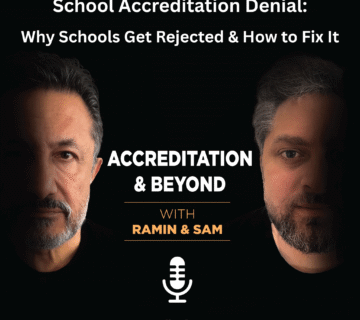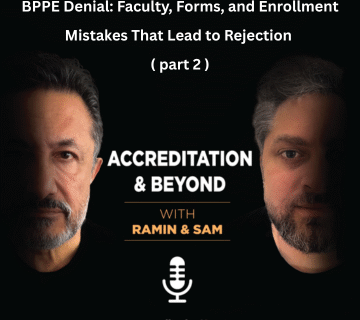
Over 200 educational institutions have faced compliance actions from BPPE—don’t let your institution be next!
As we continue our series on navigating compliance with the Bureau for Private Postsecondary Education (BPPE) regulations, this sixth installment explores how to handle BPPE inspection results, manage institutional changes, and ensure readiness for unannounced inspections.
In this article, you’ll learn:
✔ How to handle BPPE compliance notices and enforcement actions
✔ Key steps for managing substantive and non-substantive institutional changes
✔ Best practices to stay prepared for unannounced inspections
At Accreditation Expert Consulting, we assist universities, vocational schools, and colleges in maintaining compliance, securing state authorization, and achieving accreditation approval.
BPPE compliance is particularly important for institutions operating in California, where regulations are strictly enforced. Higher education institutions across the U.S. must also adhere to evolving accreditation and compliance requirements to maintain their legitimacy and avoid fines.
Managing BPPE Inspection Results
Review and Finalization
After an inspection, a BPPE compliance analyst will discuss the findings with institutional staff, ensuring they understand the violations (if any) and required corrective actions.
Notices to Students
Institutions must post a “Notice to Students” in visible areas across campus for at least 90 days, directing students to the BPPE website for detailed inspection results.
For BPPE’s latest inspection reports, visit: BPPE Official Site
Handling BPPE Compliance Notices
Notice to Comply (NTC)
If minor violations are found during an inspection and not corrected immediately, BPPE issues an NTC (Notice to Comply) that is publicly listed on their website. Institutions have 30 days to resolve the violations and submit documentation. Failure to respond may lead to penalties.

Enforcement Referral
For major violations, BPPE refers cases to its Enforcement Unit for further investigation. This can lead to citations, legal action, or even operational suspension.
Need guidance on BPPE enforcement actions? Get expert support here: Schedule a Consultation
Preparing for Unannounced BPPE Inspections
BPPE conducts unannounced inspections to ensure continuous compliance. To stay prepared, institutions should:
✔ Regularly update catalogs and School Performance Fact Sheets on their website
✔ Keep all annual report documents accurate and readily accessible
✔ Ensure faculty qualifications and job placement records are well-documented
Want a BPPE audit checklist? Download the Compliance Checklist
Managing Institutional Changes & Compliance
Substantive Changes (Require BPPE Pre-Approval)
Institutions must receive prior approval from BPPE for major changes, including:
✔ Changes in educational objectives or curriculum
✔ Ownership transfers or new governing structures
✔ Significant changes in instructional methods (e.g., online programs vs. on-campus)
Non-Substantive Changes (BPPE Notification Required)
✔ Minor location adjustments or faculty updates
✔ New program additions without major curriculum modifications
Learn more about BPPE change requirements: BPPE Compliance Guide
Institutional Closure Procedures
When closing a location, institutions must:
✔ Submit a 30-day notice to BPPE with details on the closure date and reasons
✔ Provide students with contact information for records retrieval
✔ Ensure students receive refunds and access the Student Tuition Recovery Fund (STRF)
For BPPE closure requirements, visit: U.S. Department of Education
Final Thoughts
BPPE compliance is a continuous effort that requires proactive inspection readiness and institutional management.
✔ By implementing these best practices, your institution can:
✔ Avoid costly fines and enforcement actions
✔ Build trust with students, faculty, and regulatory agencies
✔ Maintain long-term operational stability




